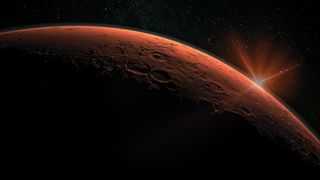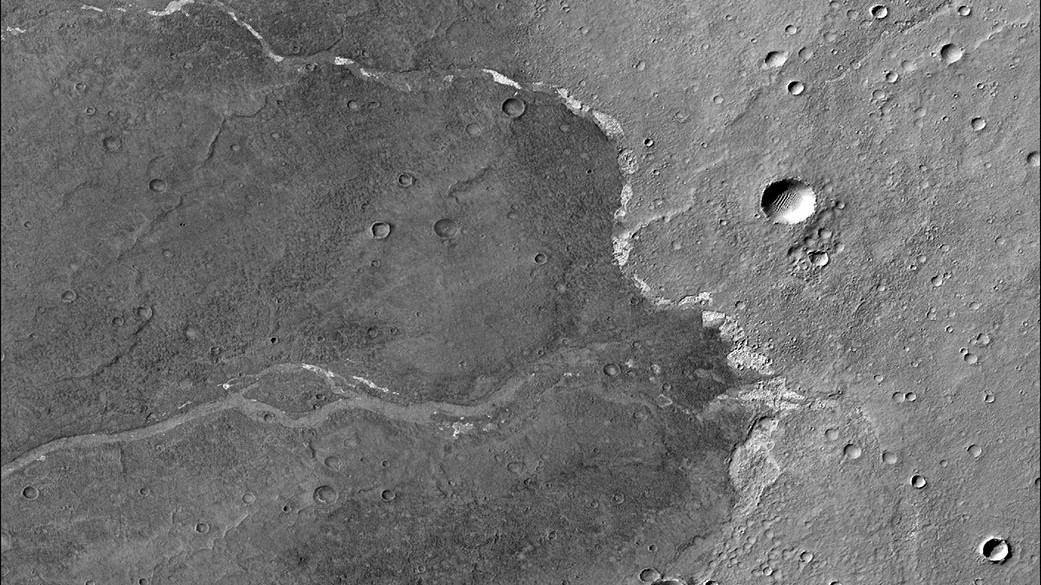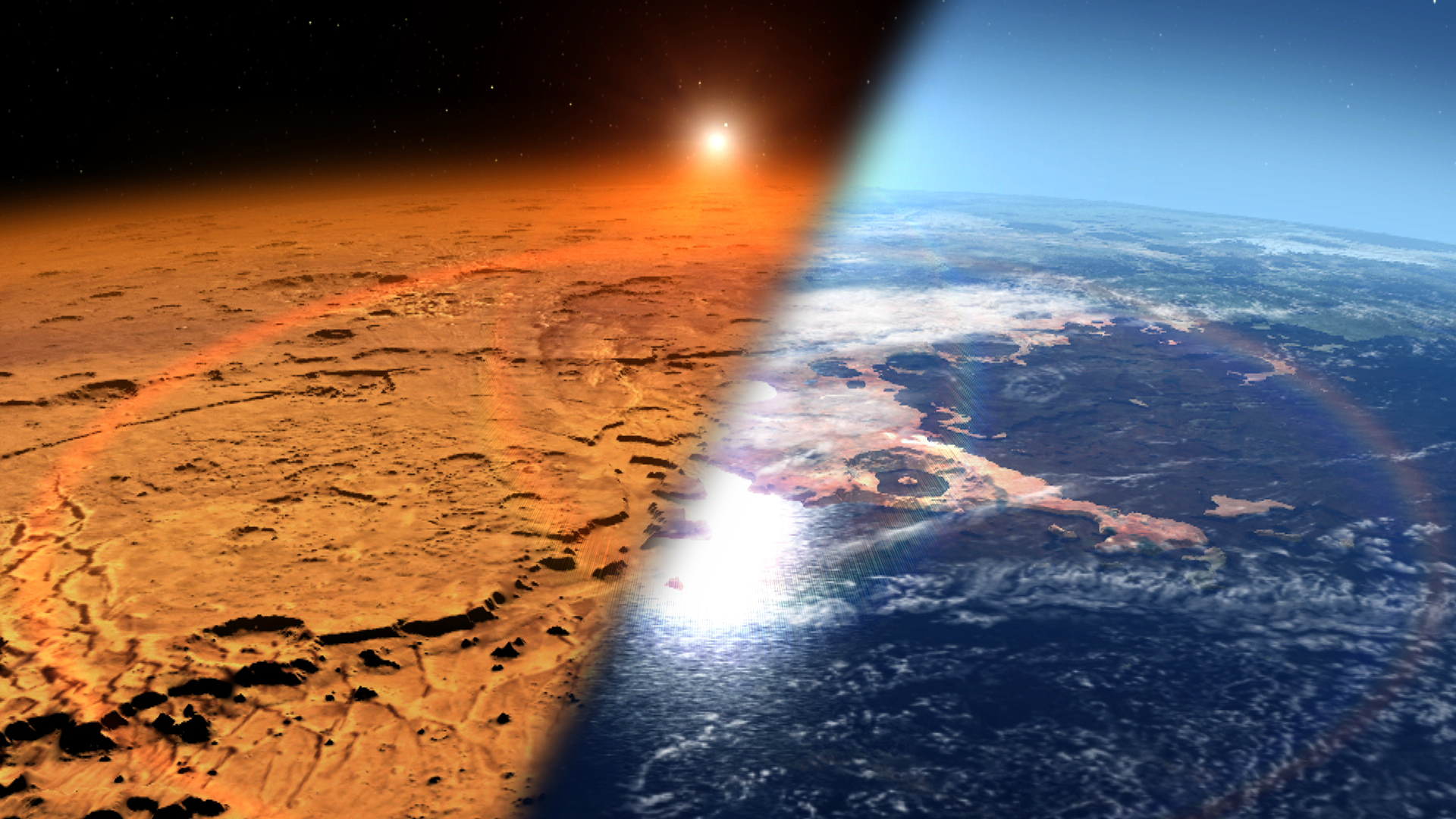what does the mars atmosphere do to our bodies
Mars' atmosphere: Facts most composition and climate

Mars' atmosphere is over 100 times thinner than Earth's and is primarily composed of carbon dioxide, nitrogen and argon gases. Oxygized dust particles kicked up from the Martian surface fill the atmosphere turning Mars' skies a rusty tan color, co-ordinate to NASA (opens in new tab).
Water exists on Mars but the atmosphere is as well sparse for information technology to final long on the surface in a liquid state. Instead, h2o on Mars is establish below the surface of the polar regions as water-ice and also as seasonal briny water flows downward hillsides and crater walls.
Despite Mars' sparse temper, the Red Planet still exhibits a dynamic climate and extreme weather condition events including impressive grit storms and even snow! But Mars hasn't always been this way. NASA's MAVEN mission scientists reported that Mars once had a thick atmosphere (opens in new tab) that could have supported surface liquid water on the surface for extended periods of fourth dimension.
Mars atmosphere composition
Co-ordinate to ESA (opens in new tab), Mars' atmosphere is composed of 95.32% carbon dioxide, 2.7% nitrogen, 1.vi% argon and 0.xiii% oxygen. The atmospheric pressure at the surface is six.35 mbar which is over 100 times less Earth's. Humans therefore cannot breathe Martian air.
For crewed Mars exploration efforts, we need to find a style to generate oxygen from the sparse, carbon dioxide temper and an experiment carried out on NASA'southward Perseverance rover has demonstrated it is possible. On Apr. xx, 2021, the rover used its MOXIE (short for "Mars Oxygen In-Situ Resource Utilization Experiment") to successfully convert carbon dioxide to oxygen on Mars. "MOXIE has more work to do, but the results from this technology demonstration are full of promise as we motion toward our goal of one 24-hour interval seeing humans on Mars." Jim Reuter, associate administrator of NASA'due south Space Technology Mission Advisers, said in a argument (opens in new tab) .
Martian climate and weather

Early in its history Mars had a thick enough atmosphere for water to run on its surface. According to NASA, some surface features suggest that Mars experienced huge floods about 3.5 billion years ago.
Orbital pictures show vast river plains and possible ocean boundaries, while several Mars rovers have found evidence of water-soaked rocks on the surface (such equally hematite or clay). Notwithstanding, for reasons that are still poorly understood, the Martian temper thinned.
Mars is much colder than Earth due to the thin atmosphere and the fact it is farther from the sun. The average temperature on Mars is about minus 80 degrees Fahrenheit (minus sixty degrees Celsius), although it tin vary from minus 195 F (minus 125 C) nigh the poles during the wintertime to as much as a comfortable 70 F (20 C) at midday near the equator.
Like Earth, Mars has four seasons merely due to the Ruby-red Planet's eccentric orbit, the length of each season varies more than on Earth, according to NASA science (opens in new tab).

| Flavour (Northern Hemisphere) | Length of Martian flavour (sols) | Length of World season (days) |
|---|---|---|
| Spring | 194 | 93 |
| Summer | 178 | 93 |
| Autumn | 142 | ninety |
| Winter | 154 | 89 |
Mars' water ice caps — made of water ice and carbon dioxide, shrink and grow in response to the seasons. These seasonal changes to the ice caps touch Mars' temper, which responds equally 1 big interconnected system, according to a statement from ESA. "The lower and middle levels of Mars' atmosphere appear to be coupled to the upper levels: at that place'southward a clear link between them throughout the martian twelvemonth," says Beatriz Sánchez-Cano, a planetary scientist at the University of Leicester, Uk.
"Each wintertime, up to a third of the mass in Mars' temper condenses to form an icy layer at each of the planet'south poles. Every jump, some of the mass inside these caps sublimates to rejoin the atmosphere, and the caps visibly shrink as a issue," ESA stated.
Giant grit devils routinely kick upward the oxidized iron dust that covers Mars' surface. Dust is likewise a permanent role of the atmosphere, with college amounts of information technology in the northern fall and winter, and lower amounts in the northern spring and summer. The grit storms of Mars are the largest in the solar arrangement, capable of blanketing the entire planet and lasting for months. These usually take place in the bound or summer.

These grit storms tin play havoc with Mars exploration missions and tin fifty-fifty ground flights (aye Earth isn't the just planet where flights can be delayed due to poor conditions!). NASA's Ingenuity Mars helicopter was due to make its 19th flying on the Crimson Planet on January. 5, 2022, when a dust storm near Jazero Crater had other plans.
"Most notable was a sharp driblet in air density — near a 7% deviation below what was observed pre-dust storm," Jonathan Bapst and Michael Mischna, of Ingenuity's weather/environment team, said in a statement. "This observed decrease would have put density below the lower threshold of safe flight and would take imparted undue gamble to the spacecraft. We also observed the outcome of dust in the corporeality of sunlight absorbed by Ingenuity's solar assortment, which fell well below normal 'clear sky' levels, a drop of about 18%." Over a calendar month passed until Ingenuity was clear to fly once more, finally acing its 19th flight on Feb. viii, 2022.
One theory as to why grit storms tin grow so big on Mars starts with airborne grit particles arresting sunlight, warming the Martian atmosphere in their vicinity. Warm pockets of air flow toward colder regions, generating winds. Strong winds lift more dust off the footing, which in turn heats the atmosphere, raising more than wind and kicking upwardly more dust. A 2015 study further suggested that the momentum of Mars — which is affected by other planets — generates planet-circling dust storms when that momentum is at its greatest during the early part of the dust tempest flavour.
At times, information technology even snows on Mars. The Martian snowflakes, made of carbon dioxide rather than water, are thought to exist very modest particles that create a fog effect rather than appearing as falling snow. The n and south polar regions of Mars are capped by ice, much of it made from carbon dioxide, not water.
How did Mars lose its atmosphere?

At some signal in Mars' history, the Red Planet lost much of its atmosphere, transforming it from a warm wet world to the cold barren plains we see today, said ESA in a argument (opens in new tab)
Mars' temper continues to "leak" out into space only how?
The leading theory is that Mars' light gravity, coupled with its lack of global magnetic field, left the temper vulnerable to pressure from the solar current of air, the constant stream of particles coming from the sun. Over millions of years, the sun's pressure stripped the lighter molecules from the atmosphere, thinning it out. This process is existence investigated by NASA'southward MAVEN (Mars Atmosphere and Volatile Evolution) mission. Other researchers hypothesize that perhaps a giant impact by a pocket-sized body would have stripped the temper away.
Boosted resource
If you would similar to meet where NASA'southward Maven mission is right at present check out their mission page (opens in new tab) with a existent-time simulated view of the spacecraft. Interested in terraforming? Check out our commodity on whether we tin can terraform Mars to make it more hospitable. Explore the science of becoming "Interplanetary" with this engaging article from Interesting Engineering (opens in new tab).
Bibliography
- Ramstad, Robin, et al. "Global mars‐solar wind coupling and ion escape. (opens in new tab)" Journal of Geophysical Research: Space Physics 122.8 (2017): 8051-8062.
- Sánchez‐Cano, Beatriz, et al. "Spatial, seasonal, and solar cycle variations of the Martian Total Electron Content (TEC): Is the TEC a skillful tracer for atmospheric cycles? (opens in new tab)." Journal of Geophysical Research: Planets 123.7 (2018): 1746-1759.
- Smith, David E., Maria T. Zuber, and Gregory A. Neumann. "Seasonal variations of snow depth on Mars. (opens in new tab)" Science 294.5549 (2001): 2141-2146.
- Banfield, Don, et al. "The atmosphere of Mars every bit observed by InSight. (opens in new tab)" Nature Geoscience 13.three (2020): 190-198.
Join our Space Forums to continue talking space on the latest missions, nighttime heaven and more! And if you take a news tip, correction or comment, allow u.s.a. know at: community@space.com.
Source: https://www.space.com/16903-mars-atmosphere-climate-weather.html
0 Response to "what does the mars atmosphere do to our bodies"
Post a Comment